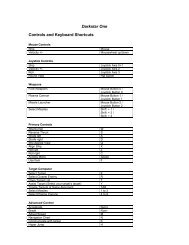Heads-Up Display Modes 35 - Metaboli
Heads-Up Display Modes 35 - Metaboli
Heads-Up Display Modes 35 - Metaboli
You also want an ePaper? Increase the reach of your titles
YUMPU automatically turns print PDFs into web optimized ePapers that Google loves.
108 Ground School<br />
GROUND SCHOOL<br />
Air combat is a complicated task; military pilots receive years of training and<br />
practice before being turned loose to fight for their country. Simulated air combat<br />
isn’t as complicated, but a thorough understanding of basic flight and combat<br />
principals is required to ensure victory.<br />
8.001 Indicated Airspeed and True Airspeed<br />
All airspeeds are not created equal. Dense air at lower altitudes both increases the<br />
lift generated by the wings, and resists the aircraft’s movement. Thinner air at<br />
higher altitudes reduces the amount of lift the wings can produce, but lets the<br />
aircraft move more easily. As a result, an aircraft moving at a constant <strong>35</strong>0 knots<br />
has different performance and flight characteristics at sea level than at 40,000 ft.<br />
This is called the aircraft’s True Airspeed (TAS).<br />
Most modern aircraft adjust the airspeed display to account for altitude. This<br />
Indicated Airspeed (IAS) displays the airspeed that would provide equivalent<br />
performance at sea level. For example, an aircraft flying at <strong>35</strong>0 knots IAS at 5,000<br />
ft has the same performance as flying <strong>35</strong>0 knots IAS at 45,000 feet; however, its<br />
TAS is actually significantly faster at the higher altitude. <strong>Display</strong>ing IAS reduces the<br />
pilot’s workload, minimizing the amount of flight performance data that must be<br />
memorized.<br />
hSome airspeed indicators show TAS; others show IAS. Always confirm<br />
the operation of each air speed indicator prior to takeoff.<br />
8.002 Velocity Vector<br />
The velocity vector is an extremely important indicator displayed on most fighter<br />
jets’ HUDs. The velocity vector shows where the aircraft’s momentum is actually<br />
taking it. For example, any time you change course, the aircraft’s momentum<br />
keeps it moving in the original direction until the thrust of the engines overcomes<br />
the momentum and establishes a new heading. Aircraft like the MiG-29 and Su-27<br />
are famous for high AOA flight, in which case the aircraft’s nose is pointing one<br />
direction, but the plane is actually moving a different direction. In this case, the<br />
velocity vector indicates where the aircraft is actually heading.<br />
hThe velocity vector is useful during landings. If the velocity vector<br />
appears short of the runway, you’re going to crash short of the runway!<br />
8.003 Angle Of Attack Indicator<br />
Whenever the velocity vector is not aligned with the aircraft’s heading, the pitch<br />
angle between the airflow and where the aircraft is pointing is called the Angle Of<br />
Attack (AOA). Anytime the pilot pitches the aircraft (whether in a steep turn, or just<br />
initiating a climb), the AOA increases. In level flight, reducing thrust generally<br />
increases AOA because the reduced thrust results in reduced lift. The aircraft<br />
begins to sink while holding a nose-level attitude.<br />
AOA and airspeed impact the amount of lift (G-load) generated by the wings.<br />
Generally, if the wing isn’t stalled, then increasing AOA will increase the amount<br />
of lift being generated. Likewise, increasing speed with a constant AOA also<br />
increases lift. Unfortunately, this also increases the drag generated by the wing,















